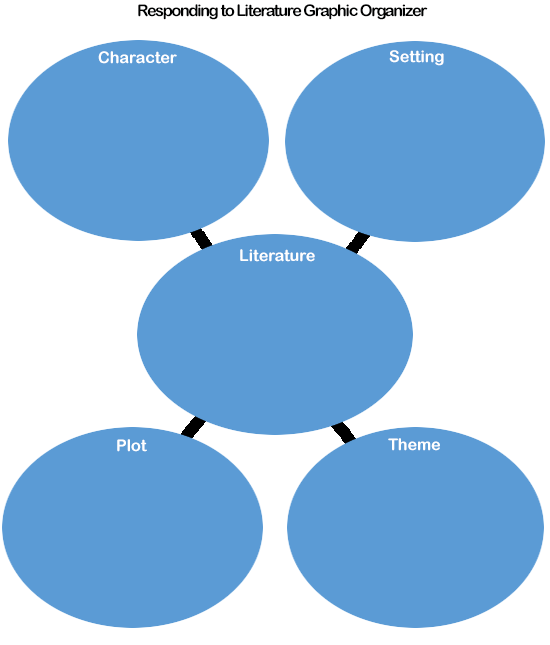Responding to Literature Learning Activity
Choose strategies that focus on the major elements of literature—character, setting, plot, and theme—to help your students respond to literature. Print out the graphic below, consult the lists below, and fill in each bubble with strategies to use with your students. For even more strategies, take a look at the links under 'Additional resources.
Character
Explanation: https://literaryterms.net/character/
Purpose: https://www.thebalancecareers.com/protagonist-1277128
Character analysis: https://www.thoughtco.com/how-to-write-a-character-analysis-1857638
Character web: https://www.dailyteachingtools.com/free-graphic-organizers.html#CharacterWebs
Interview: One student roleplays a character from the story and answers questions from an 'interviewer.'
Act it out: Two students roleplay characters from the story and talk about what has happened to them.
Tableau: A reading strategy used to increase comprehension by connecting to the emotions of the characters. Students read a portion of text, freeze, then discuss what the characters are feeling at that specific moment in the story.
WALTER (Words, Actions, Looks, Thoughts, [othErs] Respond)
Setting
Explanation: http://literary-devices.com/content/setting
Draw places portrayed in the story.
Design a travel brochure based on the setting in the story.
Make a poster of the setting.
Map the world of the story.
Reconstruct
Build a house or other building from the story out of cardboard or construction paper.
Plot
Construct a timeline for the story's events.
Put story events into song by writing lyrics or creating a song parody.
Storyboard it: https://www.scholastic.com/teachers/articles/teaching-content/what-are-storyboards/
Take a deep dive into plot structure: http://www.readwritethink.org/classroom-resources/lesson-plans/teaching-plot-structure-through-401.html?tab=4
Theme
Explanation: https://literarydevices.net/theme/
Compare stories with similar themes.
Conduct a panel discussion on the story's topic or theme.
Provide multiple stories or books on one theme.
Report: connect the theme to what is happening in the news or daily life.
Tell a book by its cover: does it illustrate the theme?
Theme in the middle: write the theme in the center of the page and put supporting evidence from the text around the theme word.
Additional resources
Ways to respond to literature click the link below.
http://www.angelfire.com/ok/freshenglish/bookreportideas.html
Literature response questions
https://www.lauracandler.com/wp-content/uploads/2018/06/responseq.pdf
Constructing a response to literature lesson for younger students
